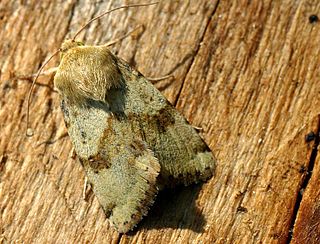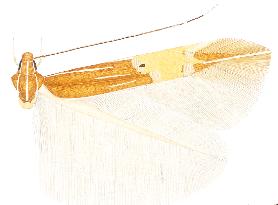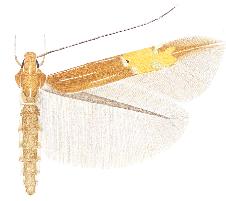
The garden dart is a moth of the family Noctuidae. It is distributed throughout much of the Palearctic. Temperate regions of Europe, Central Asia and North Asia, as well as the mountains of North Africa. Absent from polar regions, on Iceland and some Mediterranean islands, as well as in Macaronesia.

Melanitis phedima, the dark evening brown, is a species of butterfly found flying at dusk. The flight of this species is erratic. They are found in south and southeast Asia.
Naera is a genus of moth in the family Gelechiidae. It contains the species Naera fuscocristatella, which is found in North America, where it has been recorded from Alabama, Kansas, Louisiana, Mississippi, Tennessee and Texas.

Thera variata, the spruce carpet, is a moth of the family Geometridae. It is found throughout Europe, North Asia and Japan. The common name spruce carpet is also used when referring to Thera britannica.

Heliothis viriplaca, the marbled clover, is a moth of the family Noctuoidea. It is found in Europe and across the Palearctic to Central Asia then to Japan, Korea and Sakhalin. In the south, it penetrates to Kashmir and Myanmar. As a migratory moth, it also reaches areas in northern Fennoscandia in some years. North of the Alps, both indigenous and immigrant individuals occur in certain areas. The heat-loving species occurs mainly on dry grasslands, fallow land, heathlands and sunny slopes and slopes and the edges of sand and gravel pits.

Mesapamea secalis, the common rustic, is a moth of the family Noctuidae. The species was first described by Carl Linnaeus in his 1758 10th edition of Systema Naturae. It is found in Europe, north-west Africa, Turkey and northern Iran.

Grammodes stolida, the geometrician, is a moth of the family Erebidae. The species was first described by Johan Christian Fabricius in 1775. It is found in Africa, southern Europe, most of Asia and Australia. It migrates to central and northern Europe as far north as England, Denmark and Finland.

Parnara bada, the African straight swift, grey swift or Ceylon swift, is a butterfly of the family Hesperiidae. It is found in south-east Asia, from India through China to Indonesia, as well as the north-east coast of Australia.

Cosmopterix facunda is a moth of the family Cosmopterigidae. It is known from Texas, United States.

Pebobs sanctivincenti is a moth of the family Cosmopterigidae. It is known from Grenada and Saint Vincent and the Grenadines.

Pyroderces aellotricha, also known as the Cosmet moth, is a moth of the family Cosmopterigidae. It is found in New Zealand, in Australia and the Cook Islands.

Pseudotelphusa paripunctella is a moth of the family Gelechiidae. It is found from most of Europe to Siberia and the Caucasus.
Helcystogramma rhabduchum is a moth in the family Gelechiidae. It was described by Edward Meyrick in 1911. It is found in Sri Lanka and India.

Scrobipalpa instabilella, the saltern groundling, is a moth in the family Gelechiidae. It was described by John William Douglas in 1846. It is found in on the Canary Islands, in Algeria, Ireland, Great Britain, Portugal, Spain, France, Belgium, the Netherlands, Germany, Denmark, Italy, Sardinia, Sicily, Greece, Cyprus and Palestine. It is also present in the United States, where it has been recorded from California.
Parapsectris ferulata is a moth in the family Gelechiidae. It was described by Edward Meyrick in 1918. It is found in South Africa (KwaZulu-Natal).
Durrantia is a moth genus of the family Depressariidae.
Durrantia arcanella is a moth in the family Depressariidae. It was described by August Busck in 1912. It is found in Mexico, Panama, Guatemala, Honduras and Venezuela.
Durrantia pugnax is a moth in the family Depressariidae. It was described by Lord Walsingham in 1912. It is found in Panama, Guatemala and Venezuela.
Antaeotricha milictis is a moth in the family Depressariidae. It was described by Edward Meyrick in 1925. It is found in Colombia and Brazil.
Imma chlorosoma is a moth in the family Immidae. It was described by Edward Meyrick in 1906. It is found in Assam, India.








